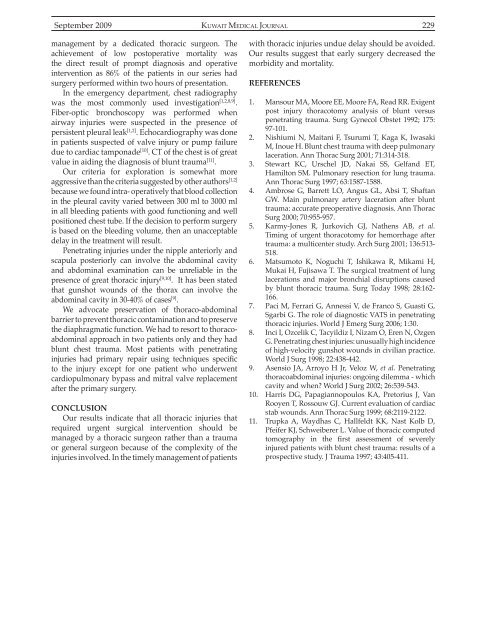Vol 41 # 3 September 2009 - Kma.org.kw
Vol 41 # 3 September 2009 - Kma.org.kw
Vol 41 # 3 September 2009 - Kma.org.kw
Create successful ePaper yourself
Turn your PDF publications into a flip-book with our unique Google optimized e-Paper software.
<strong>September</strong> <strong>2009</strong><br />
KUWAIT MEDICAL JOURNAL 229<br />
management by a dedicated thoracic surgeon. The<br />
achievement of low postoperative mortality was<br />
the direct result of prompt diagnosis and operative<br />
intervention as 86% of the patients in our series had<br />
surgery performed within two hours of presentation.<br />
In the emergency department, chest radiography<br />
was the most commonly used investigation [1,2,8,9] .<br />
Fiber-optic bronchoscopy was performed when<br />
airway injuries were suspected in the presence of<br />
persistent pleural leak [1,2] . Echocardiography was done<br />
in patients suspected of valve injury or pump failure<br />
due to cardiac tamponade [10] . CT of the chest is of great<br />
value in aiding the diagnosis of blunt trauma [11] .<br />
Our criteria for exploration is somewhat more<br />
aggressive than the criteria suggested by other authors [1,2]<br />
because we found intra- operatively that blood collection<br />
in the pleural cavity varied between 300 ml to 3000 ml<br />
in all bleeding patients with good functioning and well<br />
positioned chest tube. If the decision to perform surgery<br />
is based on the bleeding volume, then an unacceptable<br />
delay in the treatment will result.<br />
Penetrating injuries under the nipple anteriorly and<br />
scapula posteriorly can involve the abdominal cavity<br />
and abdominal examination can be unreliable in the<br />
presence of great thoracic injury [9,10] . It has been stated<br />
that gunshot wounds of the thorax can involve the<br />
abdominal cavity in 30-40% of cases [9] .<br />
We advocate preservation of thoraco-abdominal<br />
barrier to prevent thoracic contamination and to preserve<br />
the diaphragmatic function. We had to resort to thoracoabdominal<br />
approach in two patients only and they had<br />
blunt chest trauma. Most patients with penetrating<br />
injuries had primary repair using techniques specific<br />
to the injury except for one patient who underwent<br />
cardiopulmonary bypass and mitral valve replacement<br />
after the primary surgery.<br />
CONCLUSION<br />
Our results indicate that all thoracic injuries that<br />
required urgent surgical intervention should be<br />
managed by a thoracic surgeon rather than a trauma<br />
or general surgeon because of the complexity of the<br />
injuries involved. In the timely management of patients<br />
with thoracic injuries undue delay should be avoided.<br />
Our results suggest that early surgery decreased the<br />
morbidity and mortality.<br />
REFERENCES<br />
1. Mansour MA, Moore EE, Moore FA, Read RR. Exigent<br />
post injury thoracotomy analysis of blunt versus<br />
penetrating trauma. Surg Gynecol Obstet 1992; 175:<br />
97-101.<br />
2. Nishiumi N, Maitani F, Tsurumi T, Kaga K, Iwasaki<br />
M, Inoue H. Blunt chest trauma with deep pulmonary<br />
laceration. Ann Thorac Surg 2001; 71:314-318.<br />
3. Stewart KC, Urschel JD, Nakai SS, Gelfand ET,<br />
Hamilton SM. Pulmonary resection for lung trauma.<br />
Ann Thorac Surg 1997; 63:1587-1588.<br />
4. Ambrose G, Barrett LO, Angus GL, Absi T, Shaftan<br />
GW. Main pulmonary artery laceration after blunt<br />
trauma: accurate preoperative diagnosis. Ann Thorac<br />
Surg 2000; 70:955-957.<br />
5. Karmy-Jones R, Jurkovich GJ, Nathens AB, et al.<br />
Timing of urgent thoracotomy for hemorrhage after<br />
trauma: a multicenter study. Arch Surg 2001; 136:513-<br />
518.<br />
6. Matsumoto K, Noguchi T, Ishikawa R, Mikami H,<br />
Mukai H, Fujisawa T. The surgical treatment of lung<br />
lacerations and major bronchial disruptions caused<br />
by blunt thoracic trauma. Surg Today 1998; 28:162-<br />
166.<br />
7. Paci M, Ferrari G, Annessi V, de Franco S, Guasti G,<br />
Sgarbi G. The role of diagnostic VATS in penetrating<br />
thoracic injuries. World J Emerg Surg 2006; 1:30.<br />
8. Inci I, Ozcelik C, Tacyildiz I, Nizam O, Eren N, Ozgen<br />
G. Penetrating chest injuries: unusually high incidence<br />
of high-velocity gunshot wounds in civilian practice.<br />
World J Surg 1998; 22:438-442.<br />
9. Asensio JA, Arroyo H Jr, Veloz W, et al. Penetrating<br />
thoracoabdominal injuries: ongoing dilemma - which<br />
cavity and when World J Surg 2002; 26:539-543.<br />
10. Harris DG, Papagiannopoulos KA, Pretorius J, Van<br />
Rooyen T, Rossouw GJ. Current evaluation of cardiac<br />
stab wounds. Ann Thorac Surg 1999; 68:2119-2122.<br />
11. Trupka A, Waydhas C, Hallfeldt KK, Nast Kolb D,<br />
Pfeifer KJ, Schweiberer L. Value of thoracic computed<br />
tomography in the first assessment of severely<br />
injured patients with blunt chest trauma: results of a<br />
prospective study. J Trauma 1997; 43:405-<strong>41</strong>1.
















